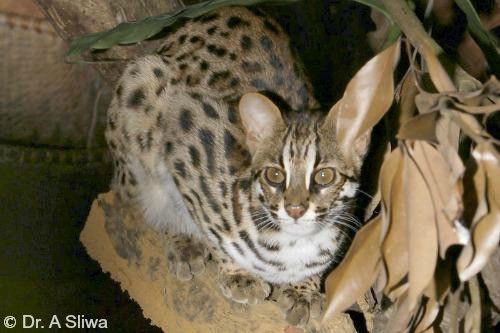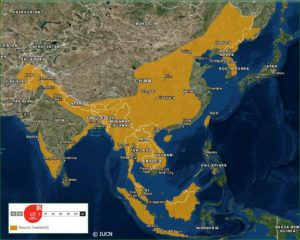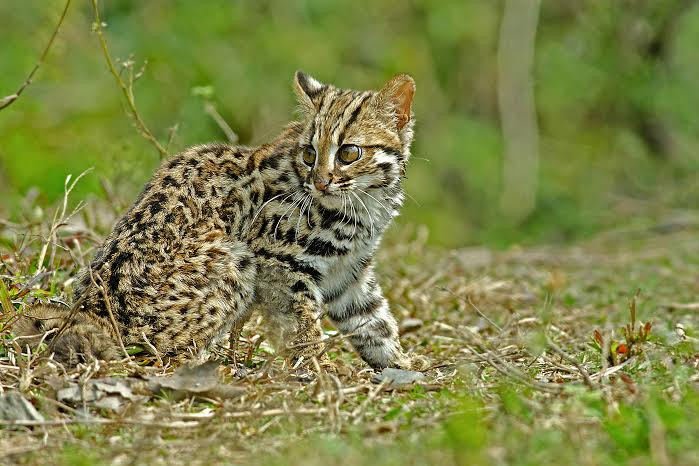 leopard cat
leopard cat
The Leopard Cat (Prionailurus bengalensis) stands as the most widely distributed among Asia’s small wild cats. Roughly the size of a domestic cat, it is distinguished by its relatively longer legs and striking coat. These felines exhibit considerable variation in size and appearance across their expansive range. Their coat color is diverse, ranging from pale tawny to yellow, red, or grey on their upper parts, contrasting with white underparts, all patterned with spots. The body sides are adorned with black rosettes, while solid spots extend down their legs and tail. Typically, four black stripes descend from the forehead to the nape, transitioning into shorter bands and elongated spots across the shoulders. A single stripe often runs along the length of their body. The fur’s length is adaptable to their habitat, with Leopard Cats in northern regions developing longer, denser coats compared to their southern counterparts.
Their head is comparatively small, featuring a short, narrow muzzle, a white chin, and two slender black cheek stripes that frame a white area. From the inner corners of their eyes, two white and four black stripes ascend towards their ears. The irises are a deep golden brown to greyish hue, and their long, rounded ears are black on the exterior, each marked with a distinctive white central spot. The tail is marked with spots above, featuring subtle, indistinct spotted rings near its buff-colored tip.
Distribution
 leopard cat range map
leopard cat range map
Click for larger image
The Leopard Cat’s distribution is extensive, encompassing a vast area from most of India, westward into Pakistan and Afghanistan, and into the Himalayan foothills. Their range stretches across much of China, northward to the Korean Peninsula, and into the Russian Far East. They are prevalent throughout Southeast Asia, including Thailand, Vietnam, and China, and inhabit the islands of Sumatra, Java, Borneo, and Taiwan, as well as smaller islands off South Korea (Tshushima and Cheju islands) and the Philippine islands of Palawan, Panay, Negros, and Cebu, possibly also Masbate. Notably, the Leopard Cat is the only wild cat species indigenous to both Japan and the Philippines. The smallest subspecies are found within the Philippine jungles, while the largest Leopard Cats inhabit the more northerly regions. Currently, there are 11 recognized subspecies of Leopard Cat.
In the dense forests of Thailand, radio telemetry studies have indicated home range sizes of 2.5 – 5.4 km². Male ranges often encompass those of several females. They demonstrate uniform habitat utilization, with a slight preference for riverine environments and roads. Peak activity levels are observed during the wet season, with significantly reduced activity in the dry season. In drier mixed habitats, studies have shown marked variations in home range sizes, activity, and prey selection.
Further research has documented average home range sizes of 12.7 km² within a protected area in Thailand and 3.5 km² on the island of Borneo, highlighting habitat-specific variations.
Typically, male Leopard Cat ranges overlap with numerous smaller female ranges. Overlap between adult males or adult females is considerable at the peripheries of their territories but minimal within the core territory areas. Density estimations range from 34 cats per 100 km² on Iriomote Island to 37.5 per 100 km² in Sabah, Malaysia, reflecting varied population densities across their distribution.
Habitat
Leopard Cats are adaptable in their habitat preferences, thriving in forests and jungles from low-lying regions to hilly and mountainous terrains, reaching elevations up to 3,254 meters. They also inhabit scrublands, semi-desert areas, secondary vegetation, and agricultural lands. In northeastern Asia, they are frequently found in pine forests, favoring more open areas with abundant fallen logs. While they tend to avoid open grasslands and steppes, they demonstrate a tolerance for living near human settlements, provided they are not persecuted. On Borneo, they have been observed in large caves, scavenging swiftlets that fall from nests on cave walls.
Compared to other Asian wild cats, except for the Jungle Cat (Felis chaus), the Leopard Cat exhibits a greater tolerance for deforestation and habitat alteration. They are known to utilize degraded forests and modified environments such as oil palm plantations, secondary forests, and farmland. These altered habitats may serve as hunting grounds due to a higher abundance of prey, such as rodents.
This species occupies a wide range of elevations, from sea level to over 4,000 meters in the Himalayas. In eastern Nepal, a Leopard Cat was photographed at 3,254 meters elevation, and in the Kangchenjunga Conservation Area, Nepal, camera traps recorded Leopard Cat presence at an impressive 4,474 meters elevation, showcasing their adaptability to high altitudes.
Ecology
The Leopard Cat is primarily a solitary animal but has been seen in pairs or with dependent offspring. They are predominantly nocturnal and crepuscular, meaning they are most active during twilight hours. However, diurnal activity is also observed, with males exhibiting more daytime activity than females.
They utilize forests and understory for resting and breeding, while hunting occurs both on the ground and in trees, demonstrating arboreal agility.
Most hunting activity occurs at night, but their activity levels are highly variable depending on the specific habitat. Like many wild cat species, they are proficient swimmers, enabling them to colonize nearby offshore islands. Showing a degree of comfort around humans, Leopard Cats are often found near villages and have historically been used by villagers for rodent control. They are also known to prey on domestic poultry. Local lore suggests they capture birds by dropping down from above, and like most small cats, they are notably agile climbers.
In Borneo, Leopard Cats have been observed preying on the high populations of rats within palm oil plantations, but they retreat to forest fragments for sleeping and breeding, illustrating their reliance on natural habitats for core life functions even when exploiting human-modified landscapes for food resources. A study in Korea revealed their diet consists of approximately 90% rodents, with a significant proportion of plant matter also consumed, indicating an opportunistic and varied diet.
Reproduction
Breeding seasons for this widespread species are variable. Leopard Cats in the northern parts of their range typically give birth in May, while in warmer southern regions, kittens have been found throughout the year, suggesting a more extended breeding season or year-round breeding. Following a gestation period of 65 – 70 days, they give birth to one to four young, with two or three being most common, in sheltered locations such as a hollow tree, rocky crevice, or burrow. Newborn kittens weigh approximately 80 grams, and their eyes open between 5 and 15 days after birth. Sexual maturity is attained around 8-12 months of age. In captivity, Leopard Cats have been recorded to live for over 15 years.
Threats
Leopard Cats face a multitude of threats across their range, including:
- Habitat loss due to deforestation and human encroachment.
- Hunting and persecution as predators of poultry, leading to direct killing.
- Unintentional capture in snares set for other wildlife species, causing injury or death.
- Higher mortality rates in areas with greater human activity and habitat fragmentation.
- Fragmentation of Leopard Cat populations, particularly in densely populated regions like India.
- Heavy commercial exploitation in regions like China for their fur, meat, and the pet trade.
- Commercial fur trade, driven by demand in international markets.
Conservation
The conservation status and population trends of Leopard Cats are not precisely known, but they are considered relatively common and widespread with stable populations, evidenced by frequent detections in camera trap studies across diverse habitats.
Survival rates as high as 92% have been documented in protected areas with minimal human disturbance, contrasting with lower survival rates of 53-82% in areas with greater human activity, highlighting the negative impact of human presence. Hybridization with feral domestic cats has been reported but is not currently considered a major threat to the species’ overall genetic integrity.
In China, commercial exploitation was historically intense. During the 1980s, hundreds of thousands of Leopard Cat furs were exported annually. From 1955 to 1981, the average annual export was around 150,000 furs. Chinese exports of Leopard Cat furs were halted in 1993. However, the long-term ecological impacts of such sustained harvesting remain uncertain.
Leopard Cats continue to be heavily targeted for the commercial fur trade, particularly in their temperate range. Japan stands as the primary consumer of wild cat furs in Asia, with Leopard Cat skins being their preferred choice, importing as many as 50,000 skins per year, underscoring the ongoing demand and pressure from the fur industry.
Further research is essential to fully ascertain both the taxonomic and conservation status of the Leopard Cat. While they appear adaptable to varied types and degrees of habitat disturbance, the limits of this tolerance are currently unknown and require further investigation to inform effective conservation strategies.
See also Iriomote Cat
[ Leopard cat photo taken in Buxa Hills, India submitted by Arghya Adhikary]
Leopard cat photo taken in Buxa Hills, India submitted by Arghya Adhikary]
Leopard cat photo taken in Buxa Hills, India submitted by Arghya Adhikary
Range Map IUCN Red List (2008)
Updated 2018
